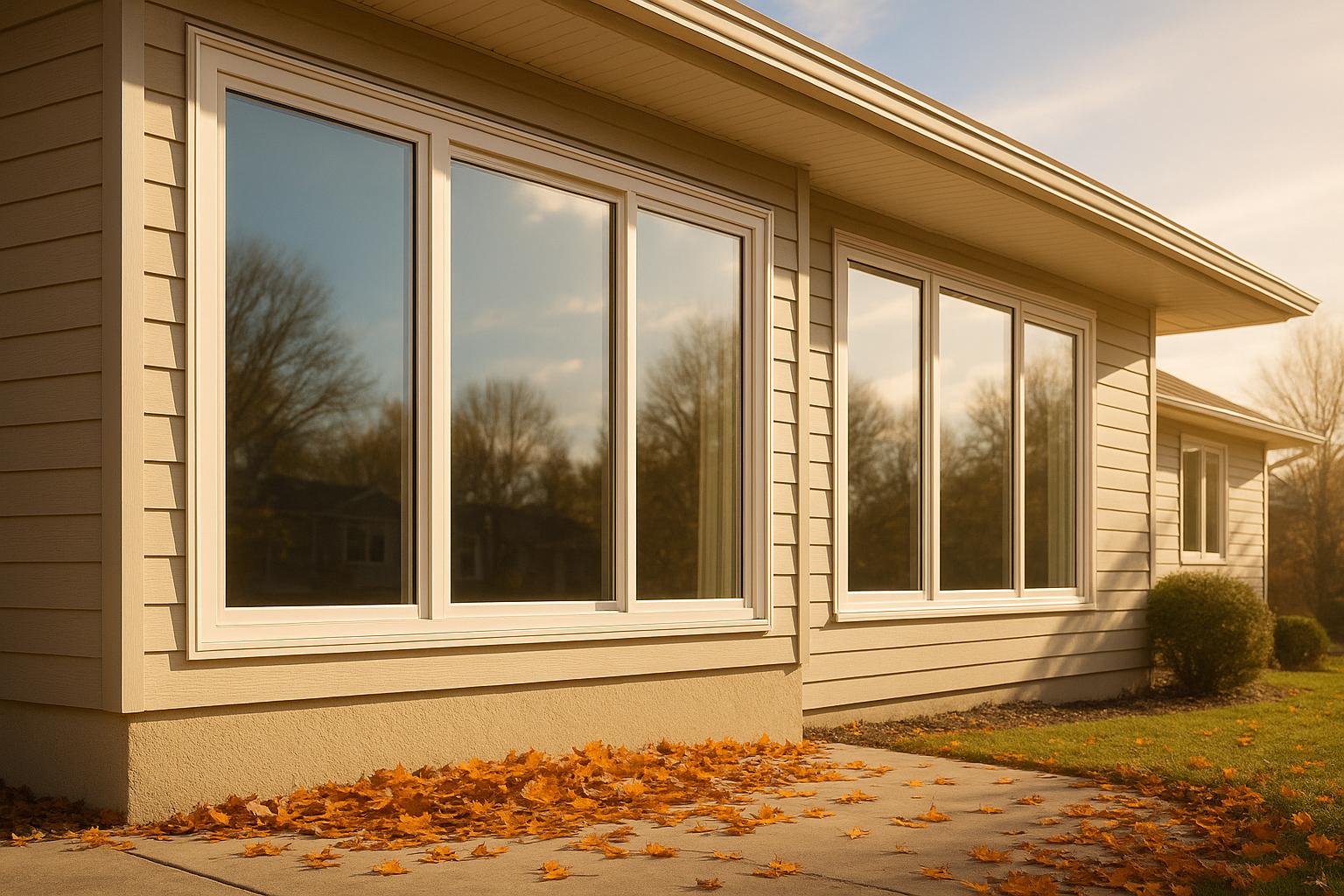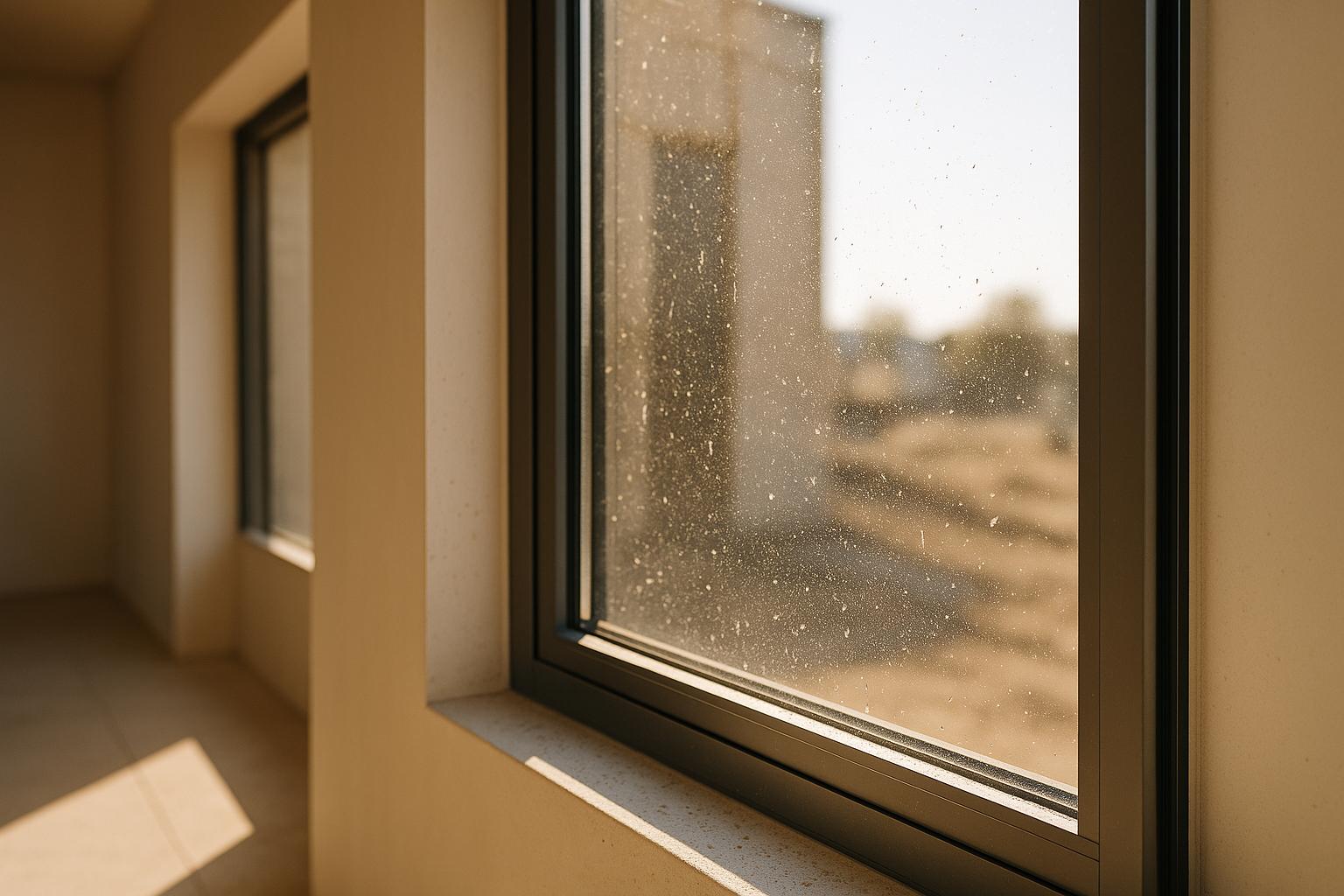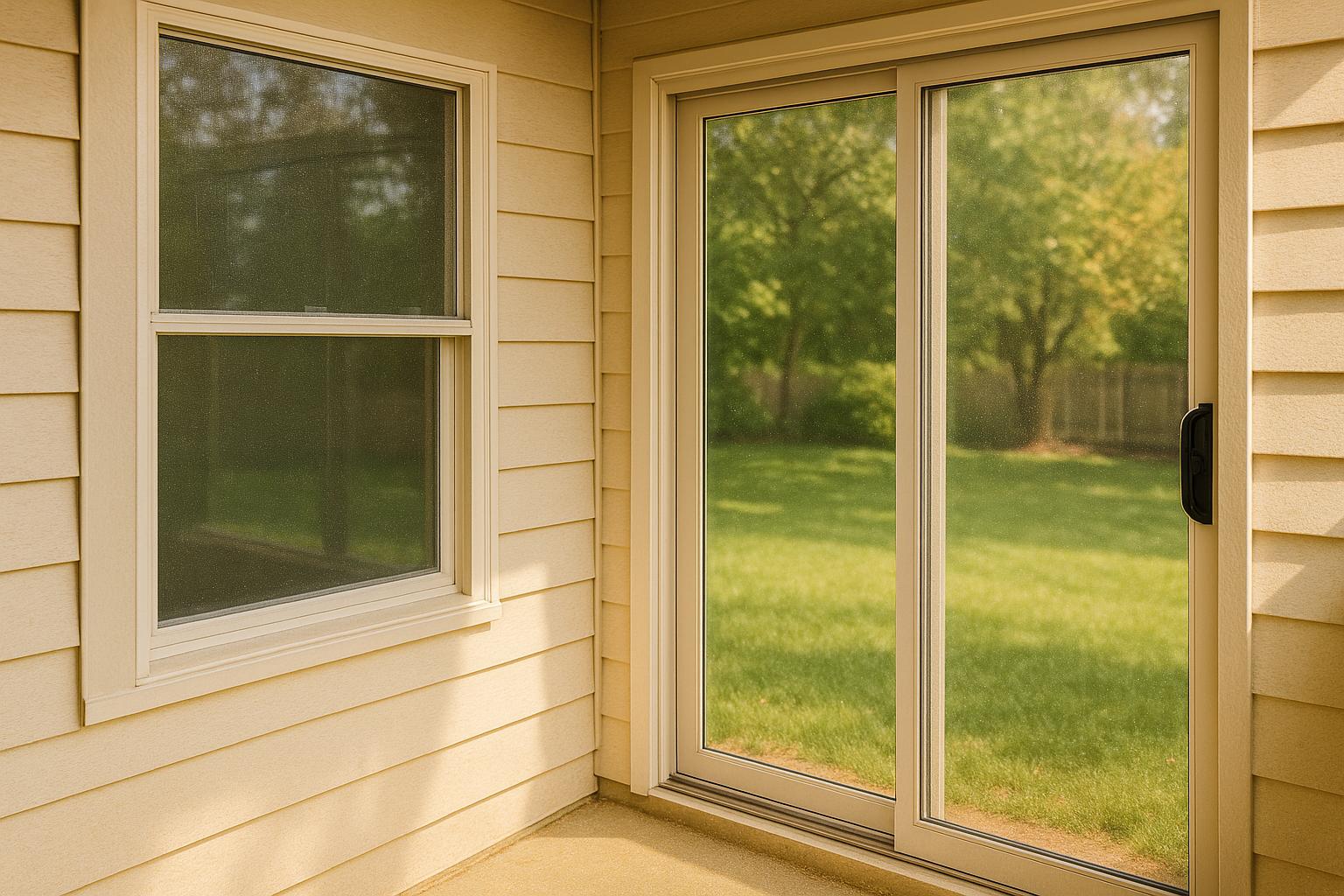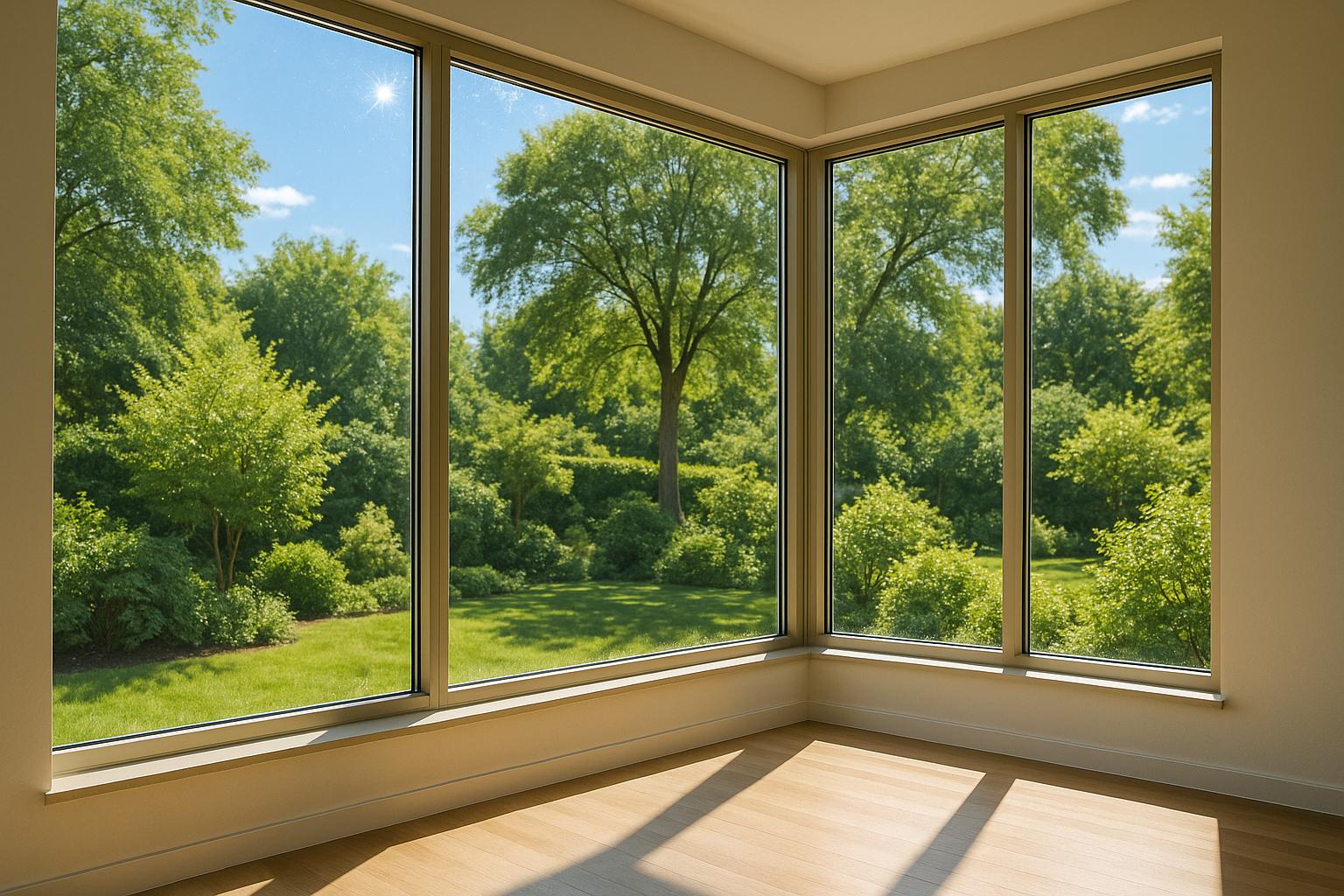Our Blog
How to Clean Windows Without Streaks
Crystal-clear windows can make your home brighter and more inviting. But streaks and smudges often ruin the results when cleaning. Here's how to avoid them:
- Use the Right Tools: Microfiber cloths, a rubber squeegee, and distilled water prevent residue and streaks.
- Choose Effective Solutions: Mix distilled white vinegar and water (1:10 ratio) or use ammonia-free commercial cleaners like Sprayway.
- Timing Matters: Clean on cloudy days or when windows are shaded to prevent quick drying.
- Proper Techniques: Apply solutions in a Z-pattern, squeegee with overlapping strokes, and dry edges with a microfiber cloth.
- Prep Your Space: Clean frames, tracks, and screens first to avoid transferring dirt back onto the glass.
For hard-to-reach areas or long-lasting results, professional services like Window Cowboy in Charlotte, NC, use advanced tools to keep windows spotless for longer. Whether DIY or hiring pros, these steps ensure streak-free windows every time.
The Secret to STREAK-FREE WINDOW CLEANING
Tools and Materials You Need
Having the right tools makes all the difference when it comes to achieving spotless, streak-free windows. Each tool plays a specific role in removing dirt and water while avoiding residue or lint.
Basic Tools
Start with microfiber cloths, which are perfect for streak-free results. These soft, lint-free cloths trap dirt and absorb moisture without scratching the glass. Use one cloth for applying the cleaning solution and another for drying to ensure the best outcome.
A quality squeegee is another essential tool. Look for one with a flexible rubber blade that evenly removes water. Keep in mind that the blade will wear out over time, and a damaged blade can leave streaks, so it’s important to replace it as needed.
For water, distilled water is a smart choice. Unlike tap water, it doesn’t leave behind mineral deposits that can create cloudy spots. Pair this with a clean bucket to keep your cleaning solution free from dirt and grime.
Once your tools are ready, the next step is selecting an effective cleaning solution.
Cleaning Solutions
Homemade solutions are a popular, budget-friendly option. One tried-and-true recipe combines 2 cups of water, 1/2 teaspoon of dish detergent, and 1/4 cup of white vinegar. This mix effectively tackles grease, grime, and mineral deposits. Another option is a simpler blend of one part distilled vinegar to ten parts warm water, which is non-toxic and effective, though it may have a stronger smell and struggle with heavy grease.
If you prefer convenience, commercial glass cleaners are widely available. According to Consumer Reports[4], Sprayway’s foaming glass cleaner is highly rated for its fast drying and versatile performance. Meanwhile, Windex remains a household favorite for its reliability.
However, avoid ammonia-based cleaners, as they can damage window tints and leave streaks or films if not applied correctly. Also, skip paper towels and abrasive pads, as they can leave lint or even scratch the glass.
| Tool/Solution | Pros | Cons |
|---|---|---|
| Microfiber Cloth | Traps dirt and prevents streaks | Needs regular washing |
| Rubber Squeegee | Removes water and solution evenly | Blade wears out and requires replacing |
| Distilled Water | Prevents mineral spots for a clear finish | Slightly more expensive than tap water |
| Dish Soap & Vinegar | Affordable, effective, and non-toxic | May need extra rinsing |
| Sprayway Cleaner | Fast drying, versatile, ammonia-free | Can have a strong odor |
With the right tools and cleaning solution, you’re well-equipped to tackle your windows.
For those with larger properties or challenging cleaning tasks, professional services like Window Cowboy offer advanced cleaning technology and specialized solutions. Their expertise ensures streak-free, long-lasting results, particularly for homes and businesses in the Charlotte, NC area.
Getting Ready to Clean
Preparation is key to achieving streak-free windows.
Best Time to Clean Windows
Cloudy days are perfect for cleaning windows. When the sun is blazing, cleaning solutions can dry too fast, leaving behind streaks and residue before you even get a chance to wipe them down. If it’s a sunny day, aim for early morning or late afternoon when the windows are shaded and the temperature is cooler. Avoid cleaning during midday when the sun is at its peak and the glass is hot. Mild weather is your best bet - cold temperatures can freeze your cleaning solution, while excessive heat can make it evaporate too quickly, causing streaks.
Once you’ve picked the right time, it’s time to prep your space.
Before You Start Cleaning
Start by cleaning the window frames and the surrounding areas before moving on to the glass. Dust and debris from frames, sills, and tracks can mix with your cleaning solution and smear across the glass. Use a dry cloth or a vacuum with a brush attachment to remove dirt from these areas.
Protect your floors and furniture by placing drop cloths or old towels around the windows. This will catch any drips and help keep hardwood or carpeted areas safe from damage.
Before applying any cleaning solution, inspect the glass for tough spots like bird droppings, tree sap, or paint splatters. These stubborn areas might need a little extra attention, such as a pre-treatment or a gentle scrape with a plastic scraper to avoid scratching the glass.
If you have kids or pets, make sure all cleaning supplies are stored safely out of reach. Consider using non-toxic, ammonia-free cleaners for added peace of mind. For high-traffic areas, adding extra floor protection can save you from dealing with unexpected spills.
How to Clean Windows Step by Step
Once your windows are prepped, it's time to dive into the cleaning process. The right approach can mean the difference between spotless, gleaming glass and frustrating streaks.
Applying the Cleaning Solution
Begin by applying your cleaning solution in a Z-shaped motion across the entire window. This method ensures even coverage and reduces the chance of missed spots that could lead to streaks. Use a microfiber cloth or a soft-bristle scrubber - both are great options. For higher windows, attach the scrubber to an extension pole for easier access.
If you're using a homemade cleaning solution, follow the recipe provided earlier. Prefer store-bought cleaners? Choose an ammonia-free option for quick drying and reduced streaks.
Always work from the top of the window downward, ensuring you cover every inch of the glass. The Z-pattern helps lift dirt while spreading the solution evenly. Once the cleaning solution is applied, you're ready to move on to the squeegee step, which is key to achieving a streak-free finish.
Squeegee Technique
The squeegee is where the magic happens, but it's also where many make mistakes. For the best results, start at the top corner of the window and pull the squeegee across in horizontal strokes, overlapping each pass by about an inch. This overlap ensures no water or solution is left behind.
Wipe the squeegee blade clean after every pass with a lint-free cloth. Skipping this step can drag dirty water back onto the glass, creating streaks. Keep a separate microfiber cloth handy specifically for this purpose.
For larger windows, attach the squeegee to an extension pole. This allows you to clean high windows safely from the ground without compromising your technique. Use steady pressure as you work side to side to remove water evenly.
Consumer Reports highlights that combining proper squeegee technique with high-quality ammonia-free cleaners, like Sprayway, can deliver streak-free results in just one pass when done correctly.
Final Drying and Polishing
Even after squeegeeing, a little moisture might linger on the glass. Use a clean, dry microfiber cloth or chamois to buff away any remaining water droplets. Focus on circular motions, especially along the edges where water tends to gather.
Inspect the window from different angles to spot any streaks. If you find them, it's usually a sign that the squeegee blade wasn’t clean or the cleaning solution had too much soap.
"Our windows hadn't been cleaned in over 3 years and after Gibson was done they looked brand new." - Cory Hymel [1]
This final polishing step is what elevates your results from good to flawless. Take your time here - rushing can undo all your hard work, leaving streaks as the glass dries completely.
For consistently spotless windows in Charlotte, NC, Window Cowboy uses these precise methods and advanced tools, earning praise for their crystal-clear results every time.
sbb-itb-4ae7296
Cleaning Screens and Tracks
Your windows might sparkle, but dirty screens and tracks can quickly undo all that effort. Keeping these areas clean not only prevents dirt from transferring back onto your freshly cleaned glass but also ensures your windows look flawless. Despite this, a survey by the American Cleaning Institute [2] revealed that over 60% of homeowners rarely or never clean their window tracks, even if they regularly clean the glass.
Window tracks, in particular, can be a magnet for dust, dirt, and even mold. As Window Cowboy explains, "When it comes to maintaining your windows and doors, one often-overlooked area is the tracks. Over time, dirt, debris, and dust can accumulate in the tracks" [1]. This buildup doesn’t just look bad - it can also affect how smoothly your windows operate.
How to Clean Window Screens
Start by removing the screens from their frames. This step is key to getting rid of trapped dirt that could otherwise transfer back onto the glass.
- Use a vacuum or a soft brush to remove loose dust and debris from both sides of the screen. A soft brush attachment works great for this.
- Rinse the screens with a gentle stream of water. For larger screens, a garden hose works well; for smaller ones, your bathtub will do the trick.
- Scrub the screens gently with a soft brush or microfiber cloth dipped in soapy water. Stick to mild dish soap mixed with water to avoid damaging the screen material. Work from top to bottom, making sure to clean both sides of the mesh.
- Rinse thoroughly to remove all soap residue, then let the screens air dry completely before reinstalling them.
Once your screens are clean and dry, pop them back into place, and you’ll notice the difference. As Kathy Parker put it, "I can't even see the screens, they are so clean. The windows look brand new" [1].
How to Clean Window Tracks
Window tracks require a more focused approach since their narrow spaces are perfect for hiding debris. Here’s how to tackle them:
- Start by vacuuming out loose dirt and debris using a crevice tool. This helps clear the bulk of the mess.
- Wipe down the tracks with a damp cloth and mild soap to remove grime. For stubborn spots, use an old toothbrush or a cotton swab to get into tight corners.
- If you spot any mold, use a vinegar-water solution to clean it up. This step is especially important in humid areas where moisture can lead to mold or rust.
- Dry the tracks thoroughly to prevent future issues like mold or corrosion.
To keep your windows in top shape, clean screens and tracks at least twice a year - spring and fall are ideal times. If you live in an area with high pollen, dust, or pollution, consider cleaning them every 2–3 months to maintain that streak-free shine.
Window Cowboy highlights that professional track cleaning "clears dust, dirt, and debris buildup" while improving window functionality and overall cleanliness [1]. For homeowners in Charlotte, NC, or anyone dealing with hard-to-reach windows, their advanced cleaning technology ensures every detail is addressed for long-lasting, spotless windows.
Professional Results with Window Cowboy

Once you've mastered the basics of DIY window cleaning, you might start to wonder if there’s a time to call in the pros. While tackling the job yourself works fine for routine upkeep, achieving that flawless, long-lasting sparkle often requires tools and expertise beyond what most homeowners have. That’s where Window Cowboy comes in. They use advanced pure water technology, which removes minerals and impurities to deliver crystal-clear, streak-free windows that stay spotless up to six times longer than standard cleaning methods [1].
This cutting-edge approach avoids the residue often left behind by tap water or traditional cleaners, keeping your windows looking pristine for weeks instead of just days. As Katie Scruggs shared, "The windows were spotless and better than any cleaning we've ever had" [1]. Time and again, customers rave about results that go beyond what they’d expected.
Complete Window Care is another hallmark of Window Cowboy’s service. They don’t just stop at the glass. Screens, tracks, mirrors, skylights, and even solar panels are all part of the package. Their skilled technicians know how to handle everything from tinted windows to tricky, hard-to-reach skylights, ensuring every detail contributes to that perfect, streak-free shine.
In Charlotte, professional window cleaning typically runs between $8 and $15 per window, depending on factors like size, quantity, and accessibility. Window Cowboy offers free estimates and often bundles services for added savings, making it a cost-effective choice for homeowners looking to cover multiple cleaning needs.
Safety and Eco-Friendly Practices are central to their process. They use ammonia-free, environmentally safe cleaning solutions, ensuring the safety of your family, pets, and landscaping. For those high or hard-to-reach windows, their technicians follow strict safety protocols, reducing the risks that come with climbing ladders or attempting to clean skylights on your own.
Window Cowboy serves a broad area, including Charlotte, Lake Norman, Mooresville, Hickory, and select South Carolina locations like Rock Hill and Lake Wylie. Most appointments can be scheduled within one to two weeks, though booking ahead during busier seasons is a smart move.
For homeowners who want streak-free windows that stay clean longer, professional service offers not just a stunning visual upgrade but also long-term value.
Summary
Getting streak-free windows isn't as tricky as it seems - if you have the right tools, timing, and techniques. Start with a quality squeegee and microfiber cloths, which are much more effective than paper towels. And here's a tip: clean your windows on a cool, cloudy day to prevent the cleaning solution from drying too quickly in the sun[2].
Next, focus on your cleaning solution. Whether you go with a store-bought option or a homemade mix, the goal is to pick something that cuts through grease and minimizes streaking[4][3].
Before tackling the glass, make sure to clean the screens and tracks first. Skipping this step can lead to debris getting back onto your freshly cleaned windows. One homeowner in Charlotte shared that cleaning these areas first made a big difference, leaving their windows looking like they were professionally cleaned.
When using a squeegee, technique matters. Work from top to bottom in overlapping strokes, wipe the blade after each pass, and finish off with a dry microfiber cloth to catch any remaining moisture.
For those tricky spots or if you want a longer-lasting shine, Window Cowboy offers professional services in the Greater Charlotte area. They use advanced methods that keep windows streak-free up to six times longer than standard techniques[1]. Plus, they can handle skylights, solar panels, and mirrors, ensuring every surface gleams.
Whether you're going the DIY route or calling in the pros, these steps will help you achieve spotless, streak-free windows every time.
FAQs
Why is distilled water better than tap water for streak-free window cleaning?
Using distilled water instead of tap water can significantly improve your chances of getting streak-free windows. Tap water is often loaded with minerals like calcium and magnesium that can dry into unsightly residue or water spots. Distilled water eliminates this issue because it’s purified and free of these impurities, giving you a cleaner, smoother finish.
To achieve the best results, combine distilled water with a reliable cleaning solution and use a lint-free cloth or a squeegee. This winning combination minimizes streaks and leaves your windows looking spotless and crystal clear.
What’s the best way to safely clean high or hard-to-reach windows without hiring a professional?
Cleaning high or hard-to-reach windows doesn't have to be a hassle if you have the right tools and take a few precautions. Start with a sturdy, non-slip ladder or an extendable pole equipped with a squeegee or microfiber attachment. Make sure the ladder is on a stable surface, and if possible, have someone nearby to lend a hand for added safety.
For the cleaning solution, mix warm water with a few drops of dish soap or use a commercial window cleaner. Use a soft sponge or cloth to apply the solution, then grab a squeegee to clear away the water, working from the top of the window down. To avoid streaks, dry the edges with a lint-free cloth for a polished finish.
If the windows are especially high or tricky to reach, it might be worth reaching out to Window Cowboy, a trusted professional window cleaning service known for delivering streak-free results in the Greater Charlotte, NC area.
Why should you clean window frames, tracks, and screens before washing the glass?
Before you start cleaning the glass, it’s a smart move to tackle the frames, tracks, and screens first. Why? This prevents dirt, dust, and debris from sneaking onto the glass during the process. Taking this step upfront makes the entire cleaning smoother and leaves your windows with that crystal-clear, streak-free shine. Skip it, and you might end up with smudges or having to redo your work - definitely not ideal!















